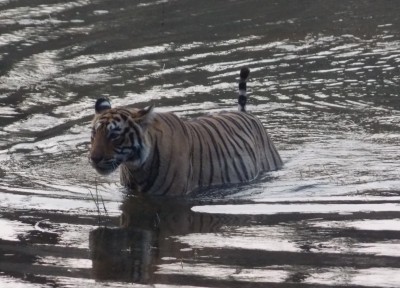

A passage through India
I landed in New Delhi, inhaled, and immediately liked India.What smelled at first like herbs and spices turned out to be mostly the aroma of burning charcoal, ubiquitous across north India; but never mind. On a group tour for a first glimpse of the subcontinent, with all the advantages that entails (such as a pre-arranged itinerary and transportation, including all the highlights) and disadvantages (traveling in a herd, with little time for oneself), I saw Delhi, Jaipur, Agra and the Taj Mahal, which was splendid, even enshrouded in early morning fog: the very definition of beauty.
From there we proceeded by bus to the Ranthambore Tiger Preserve, where, on the first of two days, I was among the lucky ones who saw a tiger in the wild. She emerged from a pool, wandered across the road where our open vehicles were parked, disdaining to take notice of us, and ambled into the forest.
Then came the magnificent Hindu temples of Khajuraho, beautifully adorned with erotic sculpture.
Varanasi, our final stop before finishing up the trip in Nepal, was India-max: dirtier, more crowded, and more chaotic than anything we had seen up to then. Or ever. Walking through the city is a challenge; sidewalks, so taken for granted in even the lowliest American slum, do not exist here. The streets are a stew of people, cars, motorbikes, cows, dogs, rickshaws, and occasional goats or monkeys. If you’re lucky you’ll see the odd elephant. It’s a bit overwhelming.
And yet, the Ganges at dawn, as the funeral pyres are lit, locals bathe in the holy stream, and the sun rises over the deserted eastern bank, is unforgettable.
So is the Ganges at night, as crowds gather on the banks, tourists drift in boats, and Hindu priests, seated throne-like along the shore under umbrella-shaped neon lights, chant prayers to the banging of drums. The atmosphere is one of frenetic religious drama, like a cross between high mass and Mardi Gras.
Separating the overcrowded city from a thinly populated eastern flood plain, the river actually seems to cleave two spirit worlds. To top it off, the river flows north here; and as the sun rises, the air gets colder. So you might as well forget everything you thought you knew.
To see anything of India, in fact, it helps to forget what you knew; one has to look with a fresh eye past (but not around) the poverty, overpopulation, and filth, and tolerate considerable complexity. “The country is a sorry mess,” writes Suketu Mehta in Time Magazine, “with the largest population of poor, sick and illiterate people in the world, its economy diving, its politics abysmally corrupt.” Yet India is also layered with wild contradictions and contrasts, and full of beauty, spirituality, and surprise.
Perhaps the best approach was summed up by Heidi, my companion, who quoted Goethe: “Nichts menschliches ist mir fremd.” Nothing human is foreign to me. Much is foreign to us, of course; but what we keep at a distance, out of fear or because of its strangeness, diminishes us. India somehow offers up a larger vision for mankind.
Latest posts by Jeff Scheuer (Posts)
- Appraising the Moment: A Cowardly New World - January 20, 2017
- Some Thoughts on Charlie Hebdo - January 12, 2015
- The Matter with Kansas - October 28, 2014
- And for What? Reflections on the First World War - August 10, 2014
- A passage through India - February 12, 2014
 Print This Post
Print This Post





Discussion Area - Leave a Comment